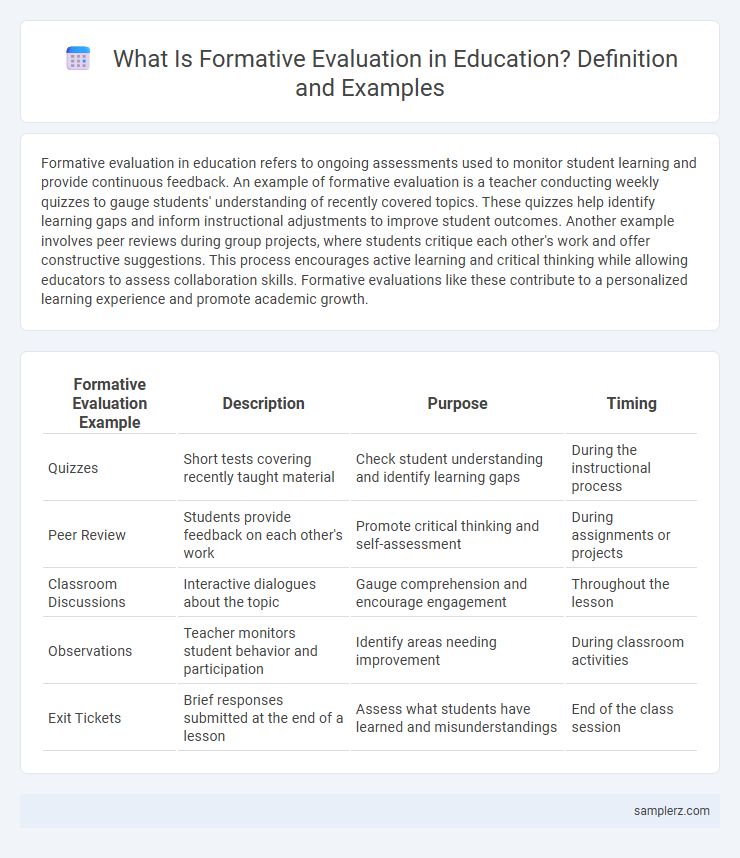Formative evaluation in education refers to ongoing assessments used to monitor student learning and provide continuous feedback. An example of formative evaluation is a teacher conducting weekly quizzes to gauge students' understanding of recently covered topics. These quizzes help identify learning gaps and inform instructional adjustments to improve student outcomes. Another example involves peer reviews during group projects, where students critique each other's work and offer constructive suggestions. This process encourages active learning and critical thinking while allowing educators to assess collaboration skills. Formative evaluations like these contribute to a personalized learning experience and promote academic growth.
Table of Comparison
| Formative Evaluation Example | Description | Purpose | Timing |
|---|---|---|---|
| Quizzes | Short tests covering recently taught material | Check student understanding and identify learning gaps | During the instructional process |
| Peer Review | Students provide feedback on each other's work | Promote critical thinking and self-assessment | During assignments or projects |
| Classroom Discussions | Interactive dialogues about the topic | Gauge comprehension and encourage engagement | Throughout the lesson |
| Observations | Teacher monitors student behavior and participation | Identify areas needing improvement | During classroom activities |
| Exit Tickets | Brief responses submitted at the end of a lesson | Assess what students have learned and misunderstandings | End of the class session |
Understanding Formative Evaluation in Education
Formative evaluation in education involves continuous assessment methods such as quizzes, class discussions, and peer reviews that provide real-time feedback to both students and teachers. These practices help identify learning gaps and adjust instructional strategies promptly to enhance comprehension and retention. Employing formative evaluation supports personalized learning, promotes student engagement, and improves overall academic outcomes.
Key Characteristics of Formative Assessment
Formative assessment includes practices such as quizzes, classroom discussions, and observational checklists that provide continuous feedback to support student learning. Key characteristics of formative assessment are its ongoing nature, emphasis on identifying learning gaps, and ability to inform instructional adjustments in real-time. This approach enhances student engagement and promotes mastery by addressing misconceptions promptly.
Classroom Quizzes as Formative Examples
Classroom quizzes serve as effective formative evaluation tools by providing immediate feedback on student understanding and guiding instructional adjustments. These low-stakes assessments help identify learning gaps and promote active engagement, enabling teachers to tailor lessons to meet diverse needs. Regular use of classroom quizzes supports continuous improvement and mastery of content throughout the course.
Peer Assessment Techniques
Peer assessment techniques in formative evaluation enhance student learning by encouraging active engagement and critical thinking through structured feedback among classmates. Methods such as peer reviews, collaborative rubrics, and reciprocal teaching enable learners to evaluate each other's work, fostering self-regulation and deeper understanding of content criteria. Research shows these techniques improve academic performance and communication skills by promoting reflective practices and increasing awareness of learning objectives.
Observational Feedback Methods
Observational feedback methods in formative evaluation include direct classroom observations where teachers receive real-time, constructive input on their instructional techniques and student engagement. Peer observations enable educators to exchange perspectives, fostering professional growth through collaborative reflection. Video recordings of lessons also serve as valuable tools for self-assessment and targeted improvement based on observed teaching behaviors.
Self-Assessment Practices for Students
Students engage in self-assessment practices by regularly reflecting on their own learning progress and identifying strengths and areas for improvement. Tools such as learning journals, checklists, and rubrics enable learners to monitor their understanding and set personal goals. This formative evaluation method fosters metacognition and encourages active involvement in the educational process.
The Role of Exit Tickets in Evaluation
Exit tickets serve as an effective formative evaluation tool by allowing teachers to quickly assess students' understanding of the lesson in real-time. These brief, focused responses provide immediate feedback, enabling educators to identify learning gaps and adjust instruction accordingly. Implementing exit tickets fosters continuous assessment, enhances student engagement, and supports personalized learning pathways.
Using Concept Maps for Ongoing Assessment
Using concept maps for ongoing assessment allows educators to visually gauge students' understanding and identify misconceptions in real-time. This formative evaluation technique supports continuous feedback by mapping relationships between concepts, which enhances critical thinking and knowledge retention. Integrating concept maps fosters active learning and helps tailor instruction to address individual learner needs effectively.
Digital Tools for Real-Time Formative Evaluation
Digital tools such as Kahoot, Nearpod, and Socrative enable real-time formative evaluation by providing instant feedback on student understanding during lessons. These platforms utilize interactive quizzes, polls, and discussion boards to monitor progress and adjust instruction accordingly. Integration of such digital tools supports differentiated learning and enhances student engagement through immediate data-driven insights.
Strategies for Effective Teacher-Student Feedback
Effective teacher-student feedback in formative evaluation includes techniques such as providing specific, actionable comments that focus on students' strengths and areas for improvement. Using strategies like questioning to prompt reflection and self-assessment encourages deeper learning and engagement. Timely feedback delivered through one-on-one discussions or digital platforms supports continuous progress monitoring and adaptive instruction.

example of formative in evaluation Infographic
 samplerz.com
samplerz.com